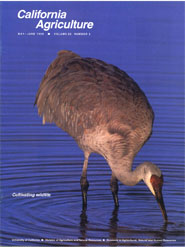


University of California
California Agriculture
|
|||
|
|||

Cultivating wildlife
Cover:
Growers and ranchers are creating ponds and taking other steps to make farmland hospitable to greater sandhill cranes and other waterfowl ... Photos by B. Moose Peterson / WRP
May-June 1999
Volume 53, Number 3 |
|||
|
University of California, 1301 S. 46th St., Bldg. 478 Richmond, CA
|